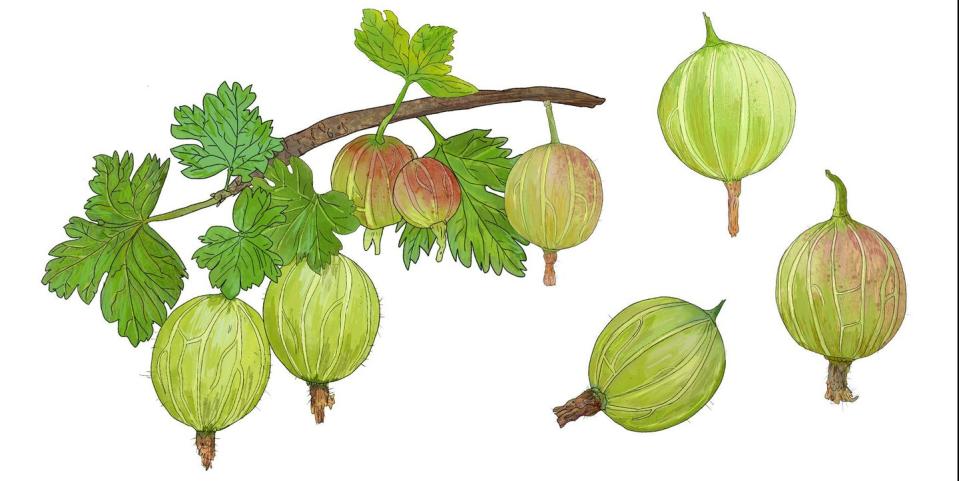Kitchen-garden diary: in praise of gooseberries

The gooseberry is one of those traditional British summer fruits that people under 30 may, tragically, never even have heard of. They are increasingly absent from supermarket shelves. A far cry from the early 20th century when Edward Bunyon would write in The Anatomy of Dessert of August gooseberries being “in such demand when schools break up”.
When kiwis were first introduced in this country, they were named the “Chinese gooseberry” to make them more acceptable to the public. Now, of course, the Chinese import abounds and our native produce is hard to come by. If you cannot find your gooseberries for sale, you may have to venture out (armed with gloves for the occasional barbs) in the hope of chancing upon them in woods.
Once you do lay hands on them you will find the fruit pleasingly tart and perfumed, and perfect for light summer desserts. They look the part: plump berries with a pastel-green hue and streaks of emerald. They are somewhere between a grape and a squash ball in size, except for the competitors at the annual show at Egton Bridge in North Yorkshire, who vie to be crowned Champion Grower of the largest gooseberry. A reminder of the days in the 19th century when there were almost 200 “gooseberry clubs” in Britain, mainly in the Midlands and the North.
It is admittedly rather early to write about eating gooseberries. While by tradition the first gooseberries are eaten at Whitsun (which this year fell on 23 May) they will still be very sharp. Waiting until the end of June for first pickings is sensible if you want to take the edge off their assertive sourness. But do not wait too long: the sourness is part of the fruit’s point and the early green berries can often have a more complex flavour than the late, sweeter ones.
This flavour profile is about more than just having time to ripen, for, like apples, gooseberries can be divided up into culinary and dessert varieties. The culinary varieties are ready first; they are usually green, ripening sometimes to yellow. Meanwhile dessert gooseberries come later in the season and are more likely to be red or possibly white – these are sweet enough to be eaten raw in a salad.
Before cooking, gooseberries require topping and tailing like green beans (unless the end result will be sieved, in which case no need to bother). They are perfect in crumbles, cobblers, syllabubs and fools. But try also this gooseberry meringue pie from Mark Hix. And these lovely gooseberry and almond galettes from Alexandra Dudley.
Take advantage of their sharpness in savoury dishes. Jane Grigson sang of the praises of the old-fashioned British classic of mackerel with gooseberry sauce: the “sweet-sour astringency” of the fruit cutting perfectly the richness of the oily fish. Indeed, the French call the gooseberry “groseille à maquereau”, the mackerel currant, in recognition of its excellence with oily fish. For a modern twist, you can try this relish employing gooseberries, cucumber and red onion, or this pickled gooseberry salad, or a mackerel tartare.
The pairing of gooseberries with elderflower is a classic. You can use elderflower cordial, like in this gooseberry ice lolly from Ed Smith, or heads of fresh elderflower, which are here turned to fritters to top Gill Meller’s lemon and gooseberry tart.
Show your friends you’re in sync with the seasons by serving them a gooseberry fizz as a dinner-party aperitif or, even better, make the fruit the main event at an afternoon tea by serving up this glorious gooseberry jam, muscat and mascarpone cake.
The high pectin level in gooseberries also makes them ideal for jelly (both a moulded set jelly and the type in a jar). This can often be made from the juice left over after making another dessert so you get two dishes for the price of one. Try this gooseberry and meadowsweet jelly with wild strawberries to spoon atop scones. And for a dessert, try this gooseberry and apricot moulded jelly from the marvellous Josceline Dimbleby.
As with all fruit, there are countless other ways to extract joy from a glut, from gin to chutney or even turning into ketchup. Plenty of reasons, then, to consider growing your own. And when it comes to the gooseberry, that is the surest way you have of laying your hands on some.

 Yahoo Sport
Yahoo Sport 





































